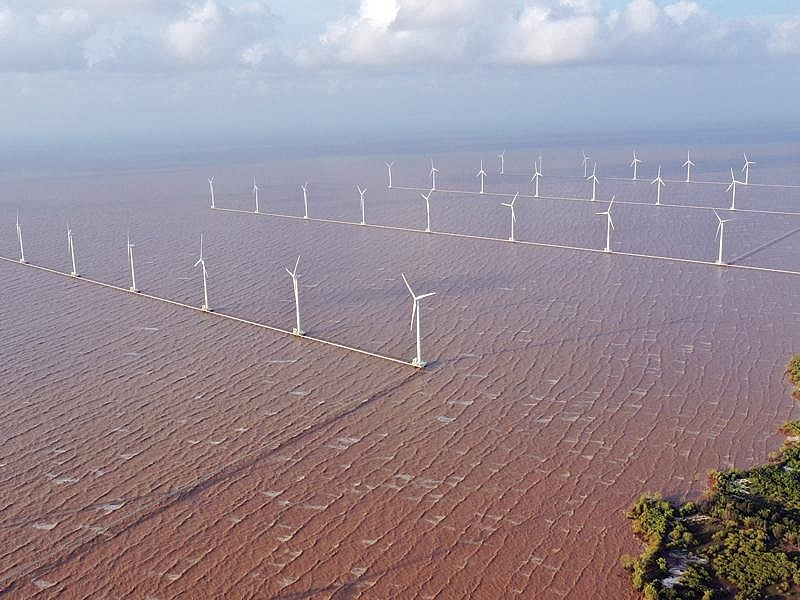Wind power investors yearn for preferential FiT deadline extension
 |
| The Bac Lieu wind farm in the Mekong Delta region |
According to state power authority Electricity of Vietnam (EVN), early this year the country was home to nine wind power projects already in commercial operation with a combined capacity touching 370MW.
In addition, 31 projects with a combined capacity of 1,645MW have signed power purchase agreements (PPAs) but have yet to come on stream and 59 other projects (2,700MW) were added to the power planning to 2025 but have yet to sign PPAs.
Dozens of wind power projects are in the investment preparation phase in the central region, the Central Highlands, and the Mekong Delta, pursuing commencing operation before November 1, 2021 to become eligible for the preferential feed-in-tariff (FiT) regulated in the prime minister’s Decision No.39/2018/QD-TTg amending and supplementing some articles of Decision No.37/2011/QD-TTg on the scheme to support wind power projects in Vietnam.
In light of Decision 39, the new level of FiT will be VND1,928 (8.5 US cents) per kWh for wind power projects on the mainland and VND2,223 (9.8 US cents) per kWh for offshore projects.
The rates are applied to wind power plants connecting to the national grid and beginning generation before November 1, 2021.
The move came eight years after the FiT of 7.8 US cents per kWh was introduced, which is said to be too low for investors to overcome perceived risks.
Commenting on the advantages of wind power over solar power, Bui Van Thinh, chairman of the Binh Thuan Wind Power Association and chairman and general director of Thuan Binh Wind Power JSC which operates Phu Lac wind farm, the usage coefficient of wind power on the power grid hovers at around 30-35 per cent [of the total number of hours yearly] compared to just 20 per cent of solar power.
Wind power is available around the day and uses less land area, at about 0.35 hectare per MW compared to 1.2ha per MW for solar power.
| Due to diverse factors, both objective and subjective, many wind power projects, however, are facing cost overruns and are threatened by delays, making it difficult for them to reach the target of starting commercial operation before the November 1, 2021 benchmark. |
Due to diverse factors, both objective and subjective, many wind power projects, however, are facing cost overruns and are threatened by delays, making it difficult for them to reach the target of starting commercial operation before the November 1, 2021 benchmark.
“Even with the new rate of 8.5 US cents per kWh for on-shore projects, investors would reap profit only if their project has good wind potential, reasonable loan sources, and suitable equipment,” Thinh commented.
Based on the experience from deploying Phu Lac wind farm, Thinh said that executing wind power projects is more complex than solar power projects as, besides the need for a solid foundation to ensure stable operation for more than 20 years, developers need specialised cranes to install super-long and heavy-lift equipment – sometimes at the height of 100m or above.
“It usually takes 12-18 months to implement a wind power project on average while solar projects take only 5-12 months,” Thinh added.
Another challenge was mentioned by Le Anh Tung, board chairman of Ecotech which has just kicked-off the construction of a wind power project in the Mekong Delta province of Soc Trang, who said there are only a few wind turbine manufacturers across the globe.
This, coupled with the trend of building sizeable wind power farms in countries around the world, pushes up equipment pricing and delivery time.
According to Scott Powers, Southeast Asia business director of Siemens Gamesa Renewable Energy Vietnam, a high-profile player in this field, wind power projects are robustly developing in regional markets like Taiwan and South Korea, heating up competition with Vietnamese investors.
“If an order was placed in March 2020, it would need about a year for the wind turbine to be delivered,” he said.
With only 18 months left until the November 1 deadline, a one-year waiting time for wind turbines makes reaching the deadline a primary concern for wind power investors.
These factors explain wind power project investors’ recent proposals to extend the deadline until the end of 2022.
Jean Francois Pierre Peron, managing director of The Blue Circle Vietnam Ltd., which operates in the green energy field, suggested that if the preferential FiT was extended by a year, the announcement should be made this late March.
If the announcement came later, investors would lack clarity and would be forced to take risks when placing an order for wind turbines, as well as encountering difficulties in securing licenses and conducting further auxiliary studies, he noted.
What the stars mean:
★ Poor ★ ★ Promising ★★★ Good ★★★★ Very good ★★★★★ Exceptional
Related Contents
Latest News
More News
- TCP Group partner with VNUS to launch water conservation project (December 25, 2025 | 14:00)
- Heavy industries set for pilot greenhouse gas quotas (December 25, 2025 | 10:00)
- Swedfund invests in MSME growth and climate action in Vietnam (December 19, 2025 | 11:42)
- GreenYellow brings solar energy to light up remote schools in Tuyen Quang province (December 19, 2025 | 08:00)
- Charge+, Grab partner to develop EV charging network in Vietnam (December 18, 2025 | 17:11)
- Linking sci-tech and innovation to Vietnam’s net-zero future (December 18, 2025 | 14:31)
- Driving double-digit growth through green and circular transformation in Vietnam (December 17, 2025 | 09:00)
- Standard Chartered and ACCA deepen collaboration to develop Vietnam’s talent for a sustainable future (December 15, 2025 | 18:18)
- Schaeffler reports strong early output from Dong Nai solar project (December 12, 2025 | 15:16)
- Forestry conference highlights biodiversity and sustainability goals (December 09, 2025 | 13:35)

 Tag:
Tag:

























 Mobile Version
Mobile Version